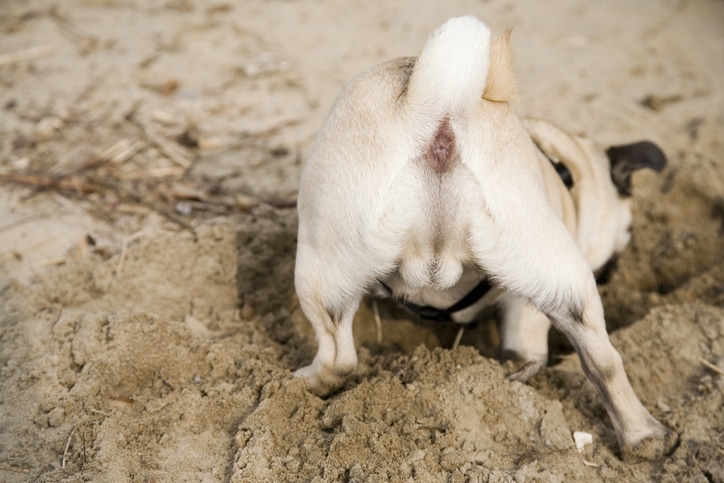While some dogs occasionally or never need their anal glands expressed, others get chronic infections and require regular emptying of their anal sacs. Shake off the ick-factor and get ready to learn everything you never wanted to know about dog anal glands. Your pooch will thank you.
What are dog anal glands?
Dog anal glands, also known as anal sacs or scent glands, are specialized sweat glands located just under the skin’s surface near the dog’s anus opening. Small and oval-shaped, dog anal glands are tucked between the external and internal sphincter muscles.
Healthy, properly functioning dog anal glands produce an oily fluid with a distinctive odor. Unique to each dog, this territorial scent marker is important in animal-to-animal communication, as it tells the dog’s sex, health, if they’ve met before and if they are friends or foes. This is what’s taking place during those common butt-sniffing greetings dogs are famous for.
This liquid marker also exits when a dog is fearful, stressed or having a bowel movement. Pooping is when dog anal glands normally empty.
Does my dog need his anal glands expressed?
Not necessarily. Some dogs never need their anal glands emptied, while other dogs suffer from chronic inflammation, which causes impacted or plugged glands.
Here are 7 signs that a dog’s anal glands need attention:
- Scooting or dragging his rear on the ground
- Excessive anus licking
- Straining, difficult or painful bowel movements
- Blood or pus in the stool or rectum area or where she’s been resting
- Foul, fishy odor
- Swollen, tender rectum
- Thick, brown or grey anal gland fluid
If you see any of these symptoms, and especially if your dog presents multiple signs, head to the vet as soon as possible to prevent more serious problems.
How to empty dog anal glands
You can safely express your dog’s anal glands at home. Full disclosure: expressing a dog’s anal glands is not for the squeamish; it can be a smelly, messy process and many prefer to leave it to the professionals, such as your veterinarian or your dog groomer.
What you’ll need:
- Paper towel or large gauze pad
- Gloves
- Lubricant
- Cleanup products, such as waterless shampoo, wipes and butt deodorizer
- An assistant to help restrain the dog
Step-by-step: How to do an external anal gland expression
- Work on a stable surface and have an assistant firmly restrain the dog.
- Place your gloved index finger and thumb on either side of the dog’s anus, about an inch out on each side.
- Gently squeeze your fingers together and you’ll see some oily fluid expelled. Wipe with the towel or pad.
- Clean/deodorize the area.
Step-by-step: How to do an internal anal gland expression
This should typically be done by your veterinarian or a person with anal gland expression experience. Even professional groomers won’t typically do an internal anal gland expression:
- Work on a stable surface and have an assistant firmly restrain the dog.
- Lubricate your gloved index finger and gently insert the tip (about 1 inch) into the dog’s anus.
- Using your index finger and thumb, feel for the small, grape-sized gland at the 5 or 7 o’clock positions.
- Gently squeeze the dog’s anal gland, milking the oily contents out until the sac has shrunk. Wipe with the gauze or pad.
- Clean the area.
- Repeat on the other gland.
How to tell if my dog’s anal glands are infected
If the expressed fluid contains blood or pus, the dog’s anal glands are infected and he needs to see the vet.
Your veterinarian or groomer can teach you how to empty dog anal glands, or you can leave it to the experts. Dealing with dog anal glands is a dirty job, but having the know-how enables you to provide your pooch with relief and to monitor the area to catch any flare-ups before they become major issues.
Featured Image Credit: Ariane Lohmar/Getty Images






